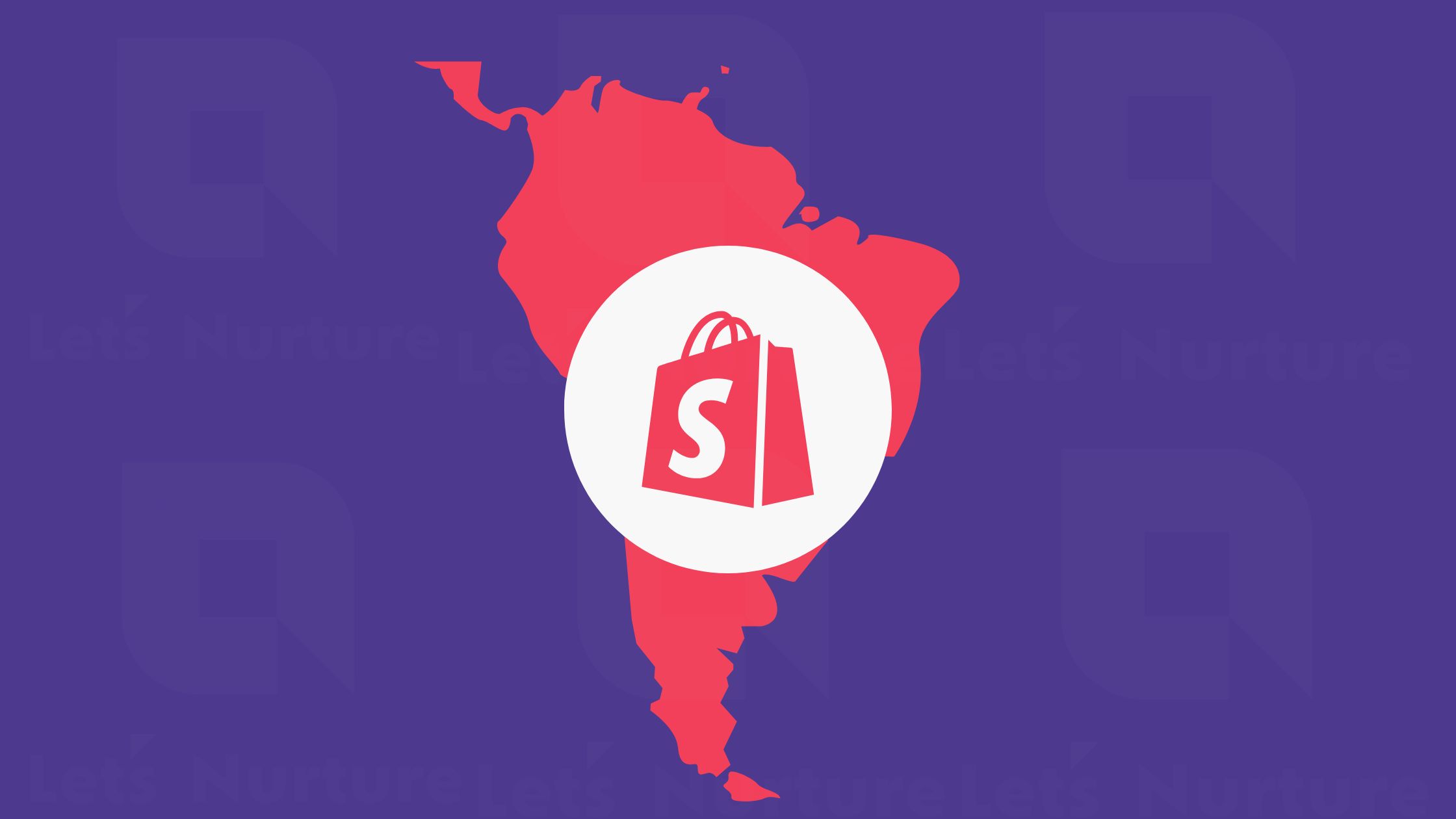- Tech Services

Concept Development
- Industry
- Emerging Tech
- Generative AI Hub
- Blog
- Contact Us

5 Shopify extensions that can be useful for developing a website for the LATAM
In Lets Nurture
24
Feb. 23712
VIEWSLatin America is a diverse and dynamic market with unique challenges and opportunities for e-commerce businesses. To successfully penetrate this market, it’s important to tailor your online store to the needs and preferences of local consumers. One way to do this is by using Shopify extensions that are specifically designed for the Latin American market.
Here are 5 Shopify extensions that can be useful for developing a website for the LATAM market:
Mercado Pago is a payment gateway For Shopify Store in LATAM Market
that provides developers with a simple and easy-to-use API to integrate payment functionality directly into their Shopify store. The API offers a range of features that allow merchants to manage their transactions effectively, including payment processing, refunds, and chargebacks. Additionally, merchants can customize payment flows using the API to meet their specific needs, such as setting up subscription-based payments or allowing customers to split payments between multiple payment methods.
Mercado Pago also offers a range of features to enhance the user experience on merchants’ websites. One such feature is installment payments, which can make it easier for customers to afford larger purchases. The app also allows merchants to offer promotions and discounts, such as free shipping or a percentage discount on the total purchase amount.
A significant advantage of using Mercado Pago is that it supports various payment methods that are popular in Latin America, such as cash payments, which are still widely used in many countries in the region. Merchants can offer customers the option to pay using cash at a local payment center, such as a convenience store or bank.
To use Mercado Pago in a Shopify store, merchants need to create an account with the service and configure the payment settings in the Shopify dashboard. This process involves setting up payment methods, configuring fraud detection settings, and creating customized payment flows if necessary. Once set up, merchants can accept payments from customers and manage their transactions directly from their Shopify store.
In summary, Mercado Pago is a powerful payment gateway that offers a range of features and functionality to help merchants manage their transactions effectively and provide a seamless payment experience for customers in Latin America. By integrating Mercado Pago into a Shopify store, merchants can increase the trust and credibility of their business and streamline payment processes to drive growth and success.
Correios Shipping Integration For Shopify Store in LATAM Market
In the context of e-commerce businesses in Brazil, the postal service offered by Correios is the most widely used shipping method. Integrating with Correios can offer several benefits, such as providing real-time shipping rates and tracking information to your customers. This can enhance customer satisfaction by providing transparency throughout the shipping process, reducing the likelihood of shipping-related issues such as lost packages or delayed deliveries.
The Correios Shipping Integration app for Shopify streamlines the shipping process by allowing you to easily generate shipping labels and track shipments directly from your Shopify dashboard. This can save you time and effort by eliminating the need to manually enter shipping information and generate labels.
Additionally, the app supports a range of shipping options offered by Correios, such as PAC (regular shipping), Sedex (express shipping), and Sedex 10 (same-day delivery), allowing you to offer your customers more flexibility in terms of shipping options. You can also set up custom shipping rules based on weight, price, and other factors, giving you greater control over your shipping costs.
By integrating with Correios, you can also take advantage of its extensive network of post offices and pick-up points throughout Brazil. This can provide your customers with more convenient shipping options and reduce the likelihood of missed deliveries.
Translate My Store For Shopify Store in LATAM Market
Selling your products in Latin America can be a lucrative opportunity, but it comes with its fair share of hurdles. One of the biggest challenges is the language barrier. Latin American consumers are more comfortable shopping online in their native language, and if your e-commerce store doesn’t speak Spanish or Portuguese, you could be missing out on a significant number of potential customers.
Enter Translate My Store – the ultimate app for breaking down language barriers and making your online store accessible to Latin American customers. This revolutionary app automatically translates your website into Spanish, Portuguese, or any other language spoken in Latin America, making it a breeze for your customers to navigate and understand your products.
With Translate My Store, you won’t have to worry about losing customers due to language barriers. Expand your customer base and reach new heights of success with this incredible tool at your fingertips.
WhatsApp Chat + Abandoned Cart For Shopify Store in LATAM Market
In Latin America, WhatsApp is the most popular messaging app, with over 500 million active users in the region. Therefore, integrating WhatsApp into your e-commerce website can be a powerful way to reach out to your customers and provide them with a personalized and convenient experience. The WhatsApp Chat + Abandoned Cart app allows you to do just that by adding a chat button to your website, making it easy for customers to contact you with any questions or concerns they may have.
In addition, the app also sends abandoned cart reminders to customers via WhatsApp. Abandoned carts are a common problem for e-commerce businesses, as many customers add items to their carts but never complete the purchase. By sending reminders via WhatsApp, you can increase the chances of customers coming back to complete their purchase. This app can help you improve customer engagement, reduce cart abandonment rates, and ultimately increase sales.
Multi Country Pricing For Shopify in LATAM Market
If you plan to sell products in multiple countries in the LATAM region, it’s crucial to adjust your pricing strategy to fit each market’s specific needs. The Multi Country Pricing app allows you to set different prices for products based on the customer’s location, currency, and other factors. This app can help you price your products competitively in different countries, making it easier to reach new customers and increase your revenue.
For example, you may find that your product is more expensive in one country than another due to exchange rates, taxes, or other factors. By adjusting your prices accordingly, you can make your product more attractive to customers in that market. The Multi Country Pricing app can help you streamline your pricing strategy, making it easier to manage your pricing across different markets and maximize your revenue.
In conclusion, integrating WhatsApp Chat + Abandoned Cart and Multi Country Pricing apps into your Shopify website can help you succeed in the LATAM market by providing a personalized and convenient customer experience and optimizing your pricing strategy for each market. By leveraging these powerful Shopify extensions, you can increase customer engagement, reduce cart abandonment rates, and ultimately drive more sales for your business.
Ecommerce growth in LATAM Market
Ecommerce growth in the LATAM market has been experiencing significant growth in recent years. The region has a large and growing population with increasing access to the internet and mobile devices. According to a report by eMarketer, the region’s ecommerce sales are expected to reach $116.51 billion in 2023, up from $84.95 billion in 2020.
One of the factors driving this growth is the increasing adoption of ecommerce platforms by consumers. The COVID-19 pandemic has accelerated this trend, as many consumers have turned to online shopping to avoid physical stores and maintain social distancing measures. This has led to a surge in demand for online retail, which is expected to continue even after the pandemic subsides.
Another factor driving ecommerce growth in the region is the increasing availability of payment methods and logistics solutions. Companies like Mercado Pago and Correios are making it easier for businesses to offer a variety of payment methods and reliable shipping options to their customers, even in remote areas of the region.
Additionally, the rise of mobile commerce, or m-commerce, is contributing to the growth of ecommerce in the region. Consumers in the LATAM market are increasingly using their smartphones to shop online, which is driving demand for mobile-optimized ecommerce websites and apps.
Top 5 eCommerce Market in LATAM
The Latin American region has seen tremendous growth in ecommerce in recent years, with many countries experiencing double-digit growth rates. Here are the top 5 markets for ecommerce in LATAM:
- Brazil: With a population of over 200 million and a growing middle class, Brazil is the largest ecommerce market in Latin America. The country has a well-developed ecommerce infrastructure, and online sales are expected to reach $53 billion by 2022.
- Mexico: Mexico is the second-largest ecommerce market in LATAM, with online sales expected to reach $22.6 billion by 2022. The country has a large and growing population, and a growing number of consumers are embracing ecommerce as a way to shop for goods and services.
- Argentina: Argentina is a rapidly growing ecommerce market, with online sales expected to reach $11 billion by 2023. The country has a well-educated and tech-savvy population, and consumers are increasingly turning to ecommerce as a way to purchase a wide range of products and services.
- Chile: Chile is a small but rapidly growing ecommerce market, with online sales expected to reach $6 billion by 2023. The country has a high level of internet penetration, and consumers are increasingly using ecommerce platforms to shop for a variety of products, including electronics, clothing, and groceries.
- Colombia: Colombia is a rapidly growing ecommerce market, with online sales expected to reach $8.3 billion by 2023. The country has a large and growing middle class, and consumers are increasingly using ecommerce platforms to shop for a wide range of products, from clothing to electronics and household goods
Top 5 ecommerce categories in LATAM Market
- Fashion: The fashion category is one of the largest ecommerce segments in LATAM, with sales reaching $18.22 billion in 2020, representing a 27% YoY growth.
- Electronics: In 2020, electronics accounted for approximately 14% of all ecommerce sales in the region, with an estimated value of $8.1 billion.
- Home appliances: The home appliances category is rapidly growing in LATAM, with sales expected to reach $7.1 billion by 2025, up from $4.9 billion in 2020.
- Beauty and personal care: This category saw significant growth in 2020, with sales increasing by 70% YoY and reaching $6.6 billion in value.
- Food and beverages: The online food and beverage market in LATAM is projected to grow at a CAGR of 14.6% between 2021 and 2026, reaching a market size of $29.3 billion by 2026.
Top 5 Shopify market in LATAM
While Shopify has a strong presence in the global ecommerce market, its reach in LATAM is still growing. However, there are several markets in the region where Shopify is becoming increasingly popular among businesses and entrepreneurs. Here are the top 5 Shopify markets in LATAM:
- Brazil: Brazil is the largest economy in the region and has a thriving ecommerce market. According to Statista, Brazil’s ecommerce market size is projected to reach US$35.4 billion by 2024. Shopify has been gaining popularity among small and medium-sized businesses in Brazil, with many entrepreneurs using the platform to start and grow their online stores.
- Mexico: Mexico is the second-largest economy in the region and has a rapidly growing ecommerce market. According to Statista, Mexico’s ecommerce market size is projected to reach US$15.8 billion by 2024. Shopify has been gaining traction in Mexico, with many businesses using the platform to reach customers across the country and beyond.
- Colombia: Colombia has a growing ecommerce market, with a projected market size of US$7.4 billion by 2024, according to Statista. Shopify has been gaining popularity among businesses in Colombia, particularly those in the fashion and beauty industries.
- Argentina: Argentina is the third-largest economy in the region and has a growing ecommerce market. According to Statista, Argentina’s ecommerce market size is projected to reach US$7.2 billion by 2024. Shopify has been gaining traction in Argentina, with many businesses using the platform to reach customers across the country and expand internationally.
- Chile: Chile has a small but growing ecommerce market, with a projected market size of US$3.8 billion by 2024, according to Statista. Shopify has been gaining popularity among businesses in Chile, particularly those in the fashion and lifestyle industries.
Average cost to develop shopify store in LATAM Market
The cost to develop a Shopify store in the LATAM market can vary depending on various factors such as the complexity of the design, features required, and the expertise of the developer. However, on average, the cost can range from $2,500 to $10,000 USD.
A simple Shopify store with basic features and a pre-made template may cost around $2,500 to $5,000 USD, while a more complex store with custom designs, advanced features, and integrations can cost up to $10,000 USD or more.
It’s important to note that the cost may also vary depending on the country in LATAM where the development is taking place. For example, countries with higher labor costs such as Brazil and Argentina may have higher development costs compared to other countries in the region.
It’s recommended to get multiple quotes from different developers to compare prices and services offered to ensure you are getting a fair and reasonable price for your Shopify store development.
Dropshipping business good for LATAM?
Dropshipping can be a viable business model in LATAM, but there are certain challenges and considerations to keep in mind.
First, shipping and delivery times can be slower in some parts of LATAM due to infrastructure challenges, which can impact customer satisfaction and lead to more returns or abandoned carts.
Second, payment methods vary across the region, with many customers preferring cash-on-delivery or local payment options. This can make it more challenging to handle payments and manage orders as a dropshipper.
Third, competition is high in many popular product categories, so finding a niche market and unique selling proposition can be key to success.
Overall, dropshipping can work in LATAM with the right approach, but it’s important to understand the challenges and adapt to the local market. It may be helpful to work with a local partner or consultant who understands the region and can provide guidance on shipping, payment methods, and customer preferences.
Some popular Shopify stores that have been successful in the LATAM market:
- Coco Bambu – A Brazilian seafood chain that offers a variety of dishes and drinks. The store sells a range of branded merchandise, including T-shirts, caps, and keychains.
- San Saru – A Colombian brand that specializes in unique and eco-friendly accessories, such as bags, purses, and wallets. The store focuses on sustainability and sources materials from local artisans and small businesses.
- Ganso – A Mexican streetwear brand that offers a range of clothing and accessories for men and women. The store is known for its edgy and urban designs and has a strong following among younger audiences.
- Chocolates Costanzo – A Mexican chocolate brand that offers a variety of gourmet chocolates and confections. The store has been in business for over 90 years and has a loyal customer base.
- Studio Caja – A Chilean brand that specializes in handmade home decor and accessories. The store offers a range of unique and stylish products, such as wall hangings, pillows, and planters.




